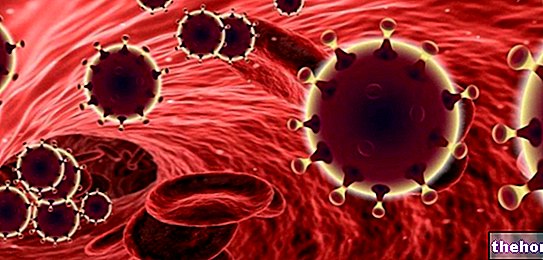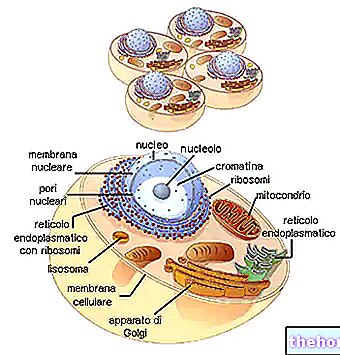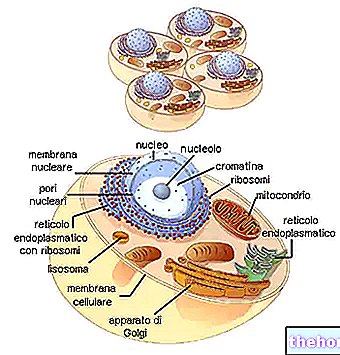Generality
RNA, or ribonucleic acid, is the nucleic acid involved in the processes of encoding, decoding, regulating and expressing genes. Genes are more or less long segments of DNA, which contain the fundamental information for the synthesis of proteins.

Figure: Nitrogen bases in an RNA molecule. From wikipedia.org
In very simple terms, RNA derives from DNA and represents the transition molecule between DNA and proteins. Some researchers call it the "dictionary for translating the language of DNA into the language of proteins".
RNA molecules derive from the union, in chains, of a variable number of ribonucleotides. A phosphate group, a nitrogenous base and a 5-carbon sugar, called ribose, participate in the formation of each single ribonucleotide.
What is the RNA?
RNA, or ribonucleic acid, is a biological macromolecule, belonging to the category of nucleic acids, which plays a central role in the generation of proteins from DNA.
The generation of proteins (also biological macromolecules) includes a series of cellular processes which, taken together, are called protein synthesis.
DNA, RNA and proteins are essential in ensuring the survival, development and proper functioning of the cells of living organisms.
What is DNA?
DNA, or deoxyribonucleic acid, is the other naturally occurring nucleic acid, along with RNA.
Structurally similar to ribonucleic acid, deoxyribonucleic acid is the genetic patrimony, that is, the “store of genes”, contained in the cells of living organisms. The formation of RNA and, indirectly, that of proteins depends on the DNA.
HISTORY OF THE RNA


Figure: ribose and deoxyribose
Research on RNA began after 1868, the year in which Friedrich Miescher discovered nucleic acids.
The first imported discoveries in this regard are dated between the second part of the "50s of the twentieth century and the first part of the" 60s. Among the scientists who participated in these discoveries, the following deserve a particular mention: Severo Ochoa, Alex Rich, David Davies and Robert Holley.
In 1977, a group of researchers, led by Philip Sharp and Richard Roberts, deciphered the process of splicing of the introns.
In 1980, Thomas Cech and Sidney Altman identified ribozymes.
* Note: to know what they are splicing of introns and ribozymes, see the chapters dedicated to the synthesis of the ANN and to the functions.
Structure
From the chemical-biological point of view, RNA is a biopolymer. Biopolymers are large natural molecules, the result of the union, in chains or filaments, of many smaller molecular units, called monomers.
The monomers that make up the RNA are the nucleotides.
THE ANN IS USUALLY A SINGLE CHAIN
RNA molecules are molecules usually made up of single chains of nucleotides (polynucleotide strands).
The length of cellular RNAs varies from less than a hundred to even several thousand nucleotides.
The number of constituent nucleotides depends on the role played by the molecule in question.
Comparison with DNA
Unlike RNA, DNA is a biopolymer generally made up of two strands of nucleotides.
United together, these two polynucleotide filaments have opposite orientations and, wrapping one into the other, form a double spiral known as a “double helix”.
A generic human DNA molecule can contain approximately 3.3 billion nucleotides per strand.
GENERIC STRUCTURE OF A NUCLEOTIDE
By definition, nucleotides are the molecular units that make up the nucleic acids RNA and DNA.
From the structural point of view, a generic nucleotide results from the union of three elements, which are:
- A phosphate group, which is a derivative of phosphoric acid;
- A pentose, that is, a sugar with 5 carbon atoms;
- A nitrogenous base, which is an aromatic heterocyclic molecule.
The pentose represents the central element of the nucleotides, as the phosphate group and the nitrogenous base bind to it.

Figure: Elements that make up a generic nucleotide of a nucleic acid. As can be seen, the phosphate group and the nitrogen base bind to the sugar.
The chemical bond that holds the pentose and the phosphate group together is a phosphodiester bond, while the chemical bond that binds the pentose and the nitrogenous base is an N-glycosidic bond.
WHAT IS THE PENTOSE OF RNA?
Premise: chemists have thought of numbering the carbons that make up organic molecules, in such a way as to simplify their study and description. Here, then, that the 5 carbons of a pentose become: carbon 1, carbon 2, carbon 3, carbon 4 and carbon 5. The criterion for assigning the numbers is quite complex, therefore we consider it appropriate to leave out the explanation.
The 5-carbon sugar, which distinguishes the nucleotide structure of RNA, is ribose.
Of the 5 carbon atoms of ribose, they deserve a special mention:
- The carbon 1, because it is what binds to the nitrogen base, through an N-glycosidic bond.
- The carbon 2, because it is what discriminates the pentose of the RNA nucleotides from the pentose of the DNA nucleotides. Connected to the 2 carbon of the RNA there are an oxygen atom and a hydrogen atom, which together form an OH hydroxyl group.
- The carbon 3, because it is the one that participates in the bond between two consecutive nucleotides.
- The carbon 5, because it is what joins the phosphate group, through a phosphodiester bond.
Due to the presence of the sugar ribose, the nucleotides of the RNA take the specific name of ribonucleotides.
Comparison with DNA
The pentose that makes up the DNA nucleotides is deoxyribose.
Deoxyribose differs from ribose by the lack of oxygen atoms on carbon 2.
Hence, it lacks the hydroxyl group OH which characterizes the 5-carbon sugar of RNA.
Due to the presence of deoxyribose sugar, DNA nucleotides are also known as deoxyribonucleotides.
TYPES OF NUCLEOTIDES AND NITROGEN BASES
The RNA has 4 different types of nucleotides.
To distinguish these 4 different types of nucleotides is only the nitrogenous base.
For obvious reasons, therefore, the nitrogenous bases of RNA are 4, specifically: adenine (abbreviated to A), guanine (G), cytosine (C) and uracil (U).
Adenine and guanine belong to the class of purines, double ring aromatic heterocyclic compounds.
Cytosine and uracil, on the other hand, fall into the category of pyrimidines, single-ring aromatic heterocyclic compounds.
Comparison with DNA
The nitrogenous bases that distinguish the nucleotides of DNA are the same as those of RNA, except for uracil. In place of the latter "c" is a nitrogenous base called thymine (T), which belongs to the category of pyrimidines.
LINK BETWEEN NUCLEOTIDES
Each nucleotide forming any RNA strand binds to the next nucleotide by means of a phosphodiester bond between the carbon 3 of its pentose and the phosphate group of the immediately following nucleotide.
THE ENDS OF AN RNA MOLECULE
Any polynucleotide strand of RNA has two ends, known as the 5 "end (read" end five prime ") and end 3" (read "end three prime").
By convention, biologists and geneticists have established that "end 5" represents the head of an RNA strand, while "end 3" represents its tail.
From the chemical point of view, the "5 end" coincides with the phosphate group of the first nucleotide of the polynucleotide chain, while the "3 end" coincides with the hydroxyl group placed on carbon 3 of the last nucleotide of the same chain.
It is on the basis of this organization that, in the books of genetics and molecular biology, the polynucleotide filaments of any nucleic acid are described as follows: P-5 "→ 3" -OH (* Note: the letter P indicates the "atom of phosphorus of the phosphate group).
Applying the concepts of 5 "end and 3" end to a single nucleotide, the "5 end" of the latter is the phosphate group bonded to carbon 5, while its 3 "end is the hydroxyl group joined to carbon 3.
In both cases, s "invites the reader to pay attention to the numerical recurrence: end 5" - phosphate group on carbon 5 and end 3 "- hydroxyl group on carbon 3.
Location
In nucleated (ie nucleus) cells of a living being, RNA molecules can be found both in the nucleus and in the cytoplasm.
This wide localization depends on the fact that some of the cellular processes, having RNA as protagonist, are located in the nucleus, while others take place in the cytoplasm.
Comparison with DNA
The DNA of eukaryotic organisms (therefore also human DNA) is located only inside the cell nucleus.
- RNA is a smaller biological molecule than DNA, usually made up of a single strand of nucleotides.
- The pentose which constitutes the nucleotides of ribonucleic acid is ribose.
- RNA nucleotides are also known as ribonucleotides.
- Nucleic acid RNA shares only 3 out of 4 nitrogenous bases with DNA. In fact, instead of thymine, it has the nitrogenous base uracil.
- RNA can reside in various compartments of the cell, from the nucleus to the cytoplasm.
Synthesis
The RNA synthesis process has as its protagonist an intracellular enzyme (ie located inside the cell), called RNA polymerase (N.B: an enzyme is a protein).
The RNA polymerase of a cell uses the DNA, present inside the nucleus of the same cell, as if it were a template, to create the RNA.
In other words, it is a kind of copier who transcribes what the DNA reports in a different language, which is that of "RNA."
Moreover, this process of synthesis of RNA, by the work of RNA polymerase, takes the scientific name of transcription.
Eukaryotic organisms, such as humans, possess 3 different classes of RNA polymerase: RNA polymerase I, RNA polymerase II and RNA polymerase III.
Each class of RNA polymerase creates particular types of RNA, which, as the reader will be able to ascertain in the next chapters, have different biological roles in the context of cellular life.
HOW THE RNA POLYMERASE WORKS
An "RNA polymerase is capable of:
- Recognize, on the DNA, the site from which to start the transcription,
- Bind to DNA,
- Separate the two polynucleotide strands of DNA (which are held together by hydrogen bonds between nitrogenous bases), so as to act on only one strand, and
- Begin synthesis of the RNA transcript.
Each of these steps takes place whenever an "RNA polymerase is about to carry out the transcription process. Therefore, they are all mandatory steps."
RNA polymerase synthesizes RNA molecules in the 5 "→ 3" direction. As it adds ribonucleotides to the nascent RNA molecule, it moves onto the template DNA strand in the 3 "→ 5" direction.
MODIFICATIONS OF THE RNA TRANSCRIPT
After its transcription, the RNA undergoes some modifications, including: the addition of some sequences of nucleotides at both ends, the loss of the so-called introns (a process known as splicing) etc.
Therefore, compared to the original DNA segment, the resulting RNA has some differences in the length of the polynucleotide chain (it is generally shorter).
Types
There are various types of RNA.
The best known and studied are: the "transport RNA (or transfer RNA or tRNA), the" messenger RNA (or messenger RNA or mRNA), the "ribosomal RNA (or ribosomal RNA or rRNA) and the small nuclear RNA (or small nuclear RNA or snRNA).
Although they play different specific roles, tRNA, mRNA, rRNA and snRNA all contribute to the realization of a common goal: the synthesis of proteins, starting from the nucleotide sequences present in the DNA.
STILL OTHER TYPES OF RNA
In the cells of eukaryotic organisms, the researchers found other types of RNA, in addition to the 4 mentioned above. For instance:
- The micro RNAs (or miRNAs), which are strands of just over 20 nucleotides in length, e
- The RNA that makes up ribozymes. Ribozymes are RNA molecules with catalytic activity, like enzymes.
MiRNAs and ribozymes also participate in the protein synthesis process, just like tRNA, mRNA, etc.
Function
RNA represents the biological macromolecule of passage between DNA and proteins, that is long biopolymers whose molecular units are amino acids.
The RNA is comparable to a dictionary of genetic information, as it allows to translate the nucleotide segments of DNA (which are then the so-called genes) into the amino acids of proteins.
One of the most frequent descriptions of the functional role, played by "RNA, is:" RNA is the "nucleic acid involved in the encoding, decoding, regulation and expression of genes".
The "RNA is one of the three key elements of the so-called central dogma of molecular biology, which states:" From DNA derives the "RNA, from which, in turn, proteins are derived" (DNA → RNA → proteins).
TRANSCRIPTION AND TRANSLATION
Briefly, transcription is the series of cellular reactions that lead to the formation of RNA molecules, starting with DNA.
Translation, on the other hand, is the set of cellular processes that end with the production of proteins, starting from the RNA molecules produced during the transcription process.
Biologists and geneticists have coined the term "translation", because from the language of nucleotides we pass to the language of amino acids.
TYPES AND FUNCTIONS
The transcription and translation processes see all the above types of RNA as protagonists (tRNA, mRNA, etc.):
- An mRNA is an RNA molecule encoding a protein. In other words, mRNAs are the proteins prior to the process of translating nucleotides into the amino acids of proteins.
The mRNAs undergo several modifications after their transcription. - TRNAs are non-coding RNA molecules, but nonetheless essential to the formation of proteins. In fact, they play a key role in deciphering what mRNA molecules report.
The name "transport RNA" derives from the fact that these RNAs carry an amino acid on them. To be more precise, each amino acid corresponds to a specific tRNA.
The tRNAs interact with the mRNA, through three particular nucleotides of their sequence. - RRNAs are the RNA molecules that make up ribosomes. Ribosomes are complex cellular structures which, moving along the mRNA, bring together the amino acids of a protein.
A generic ribosome contains, within it, some sites, in which it is able to house the tRNAs and make them meet with the mRNA. It is here that the three particular nucleotides mentioned above interact with the messenger RNA. - SnRNAs are RNA molecules that participate in the process of splicing of introns present on the mRNA. Introns are short segments of non-coding mRNA, useless for the purposes of protein synthesis.
- Ribozymes are RNA molecules that catalyze the cutting of ribonucleotide strands, where necessary.

Figure: translation of the mRNA.








.jpg)


















